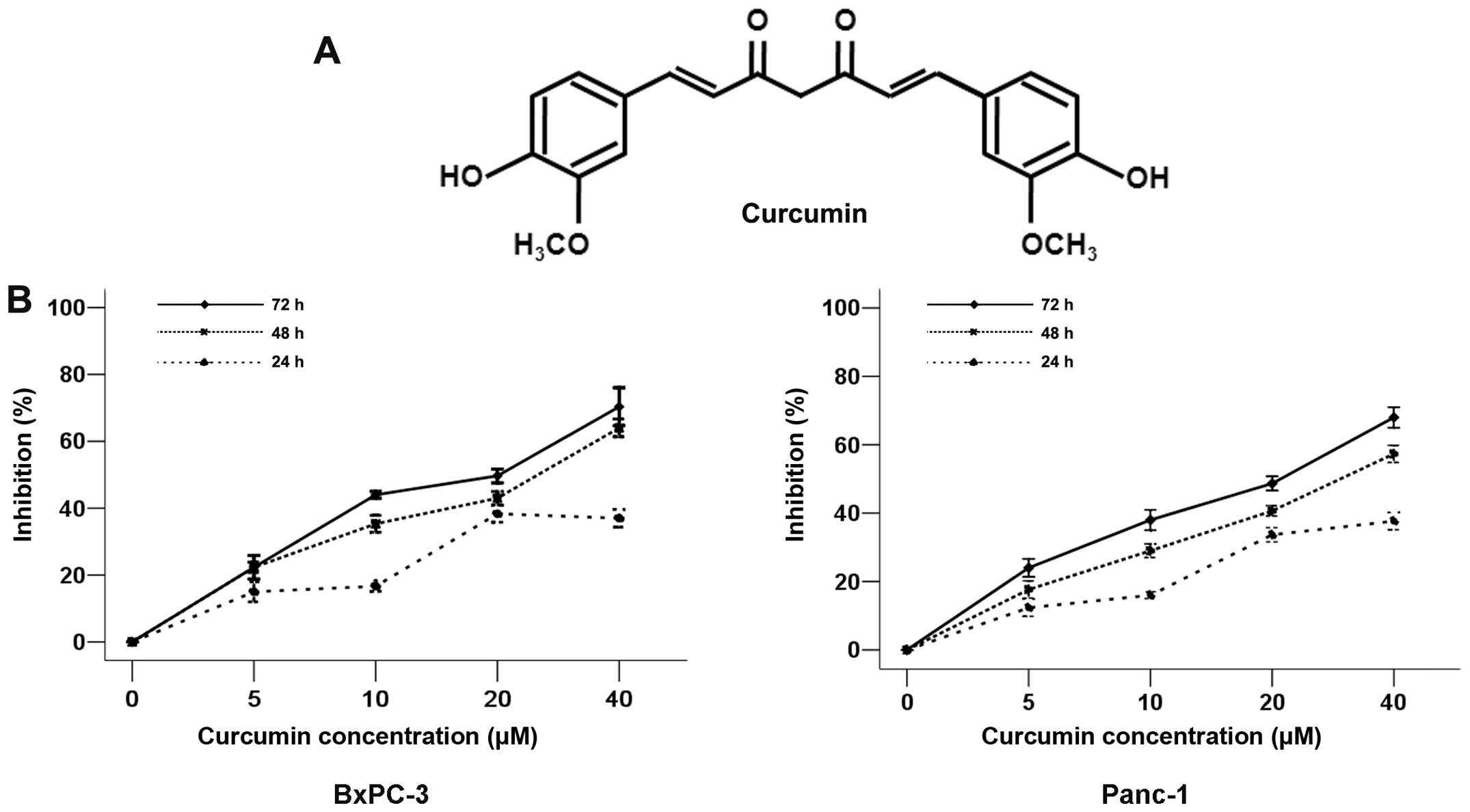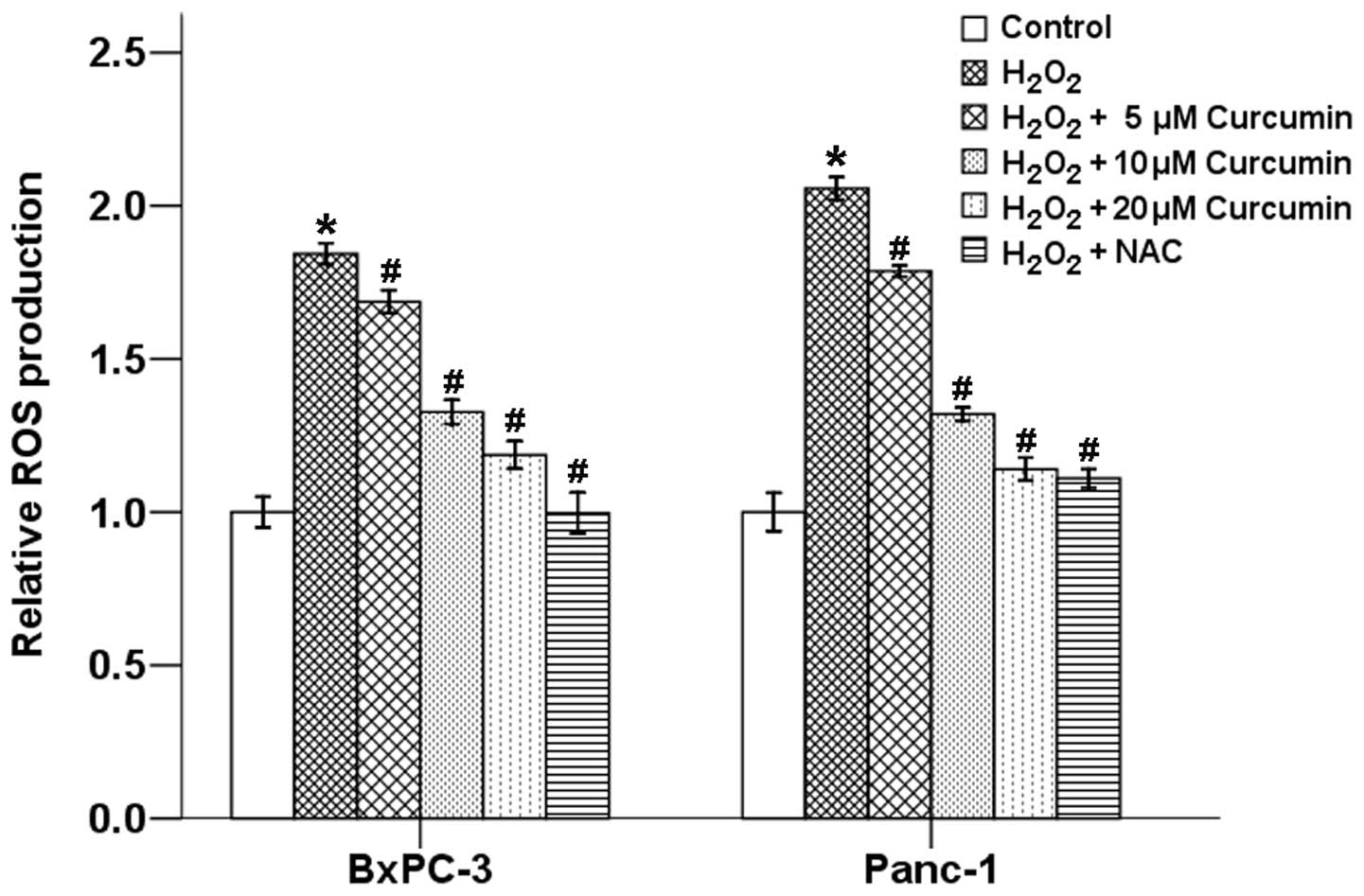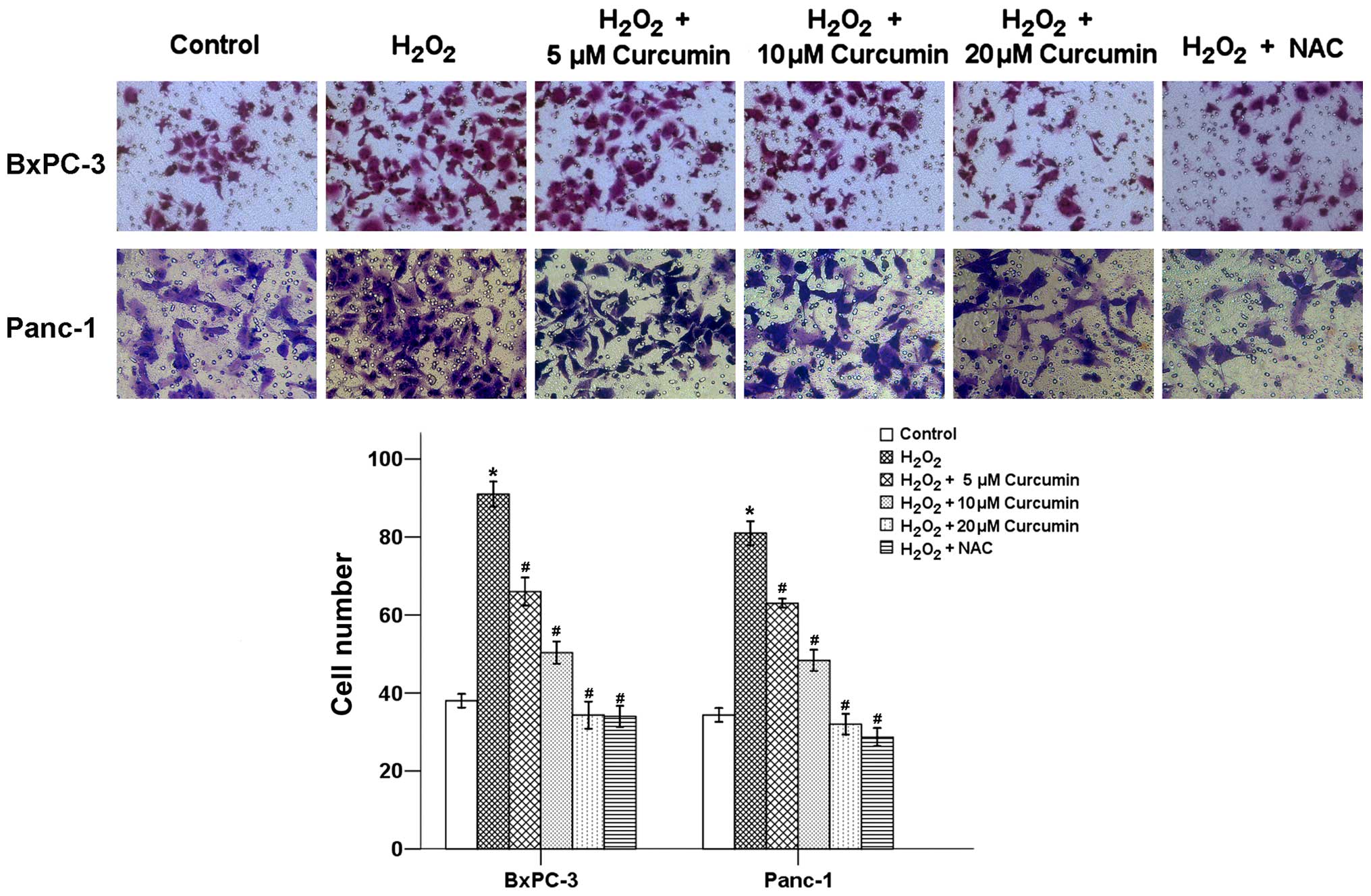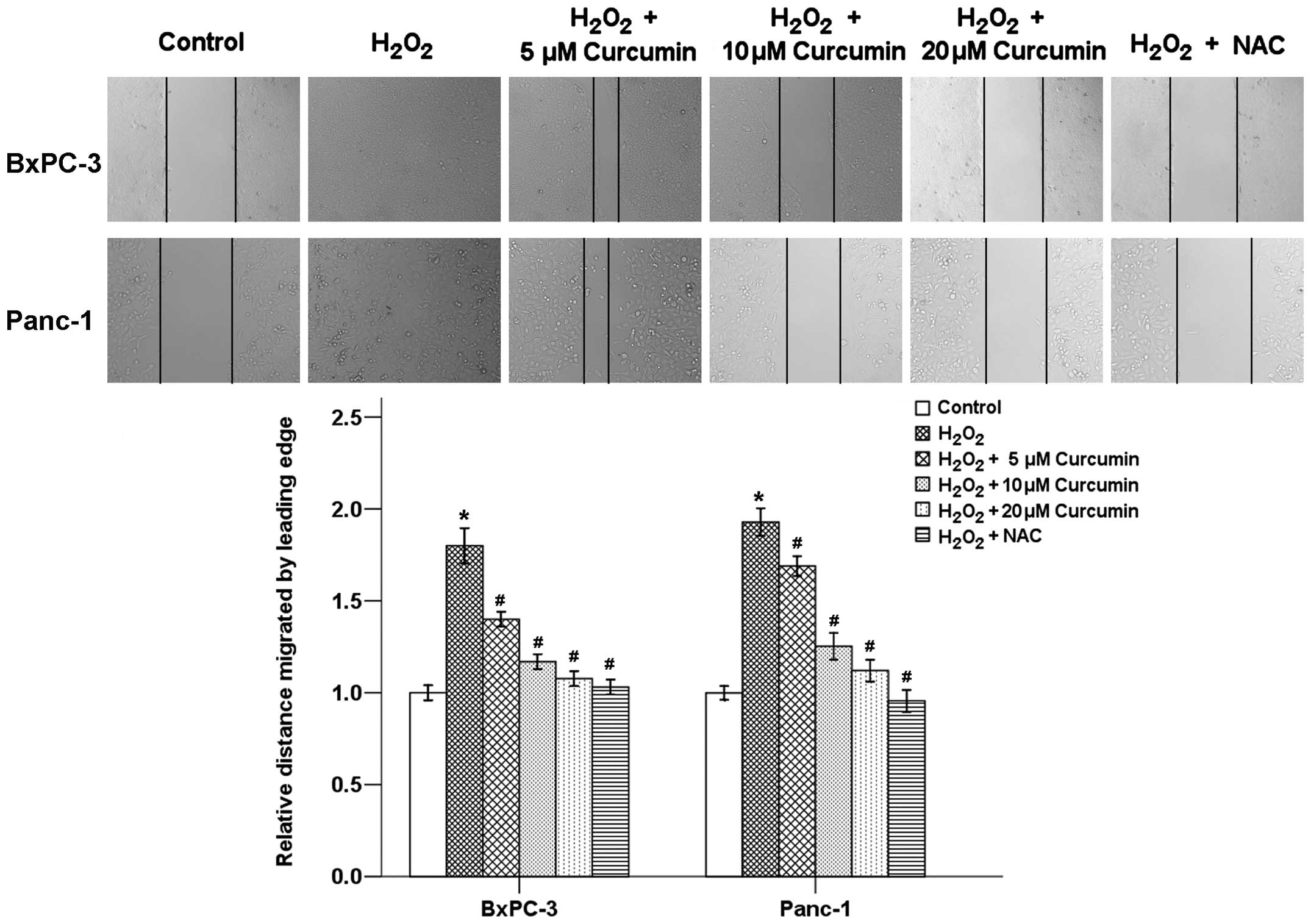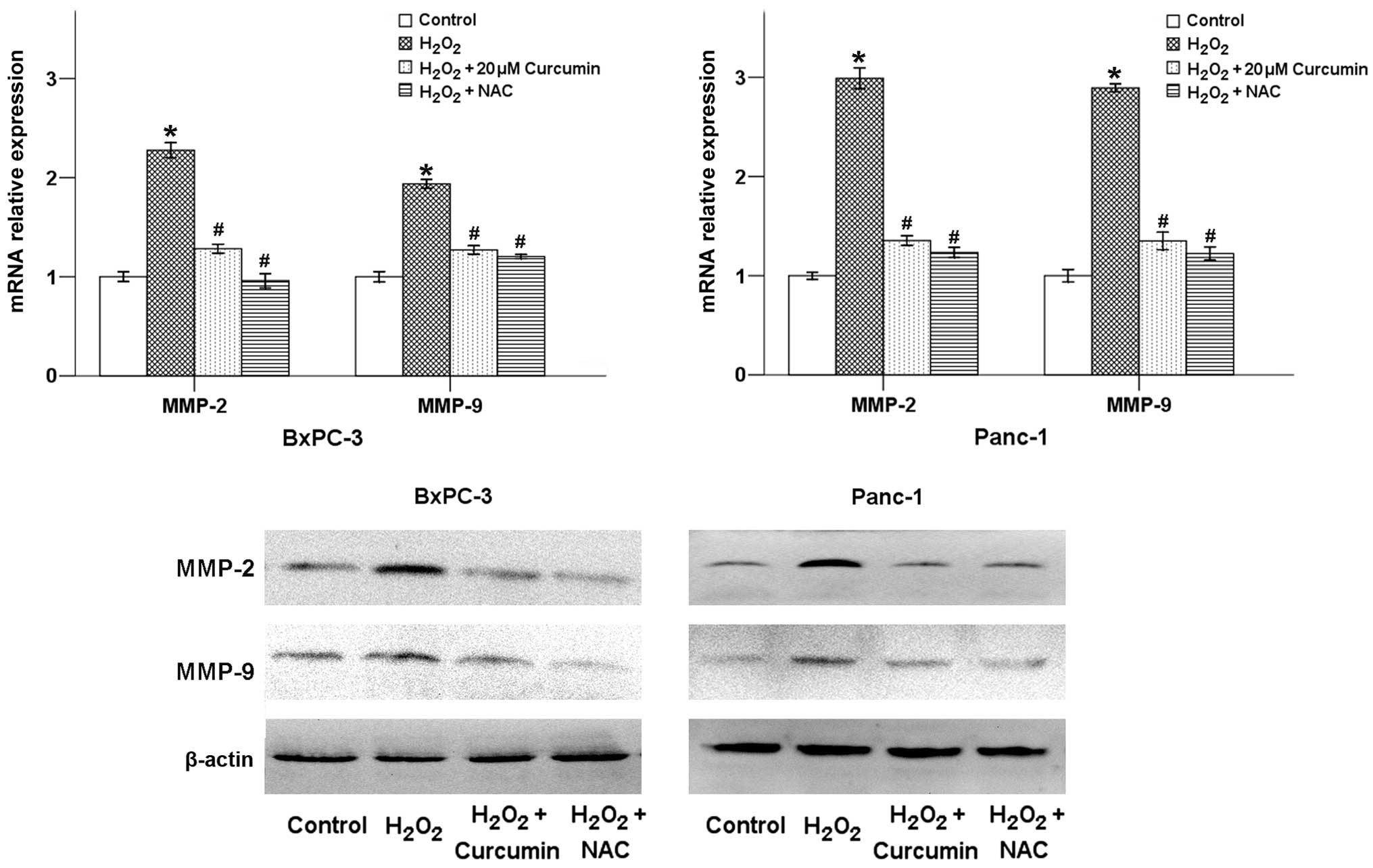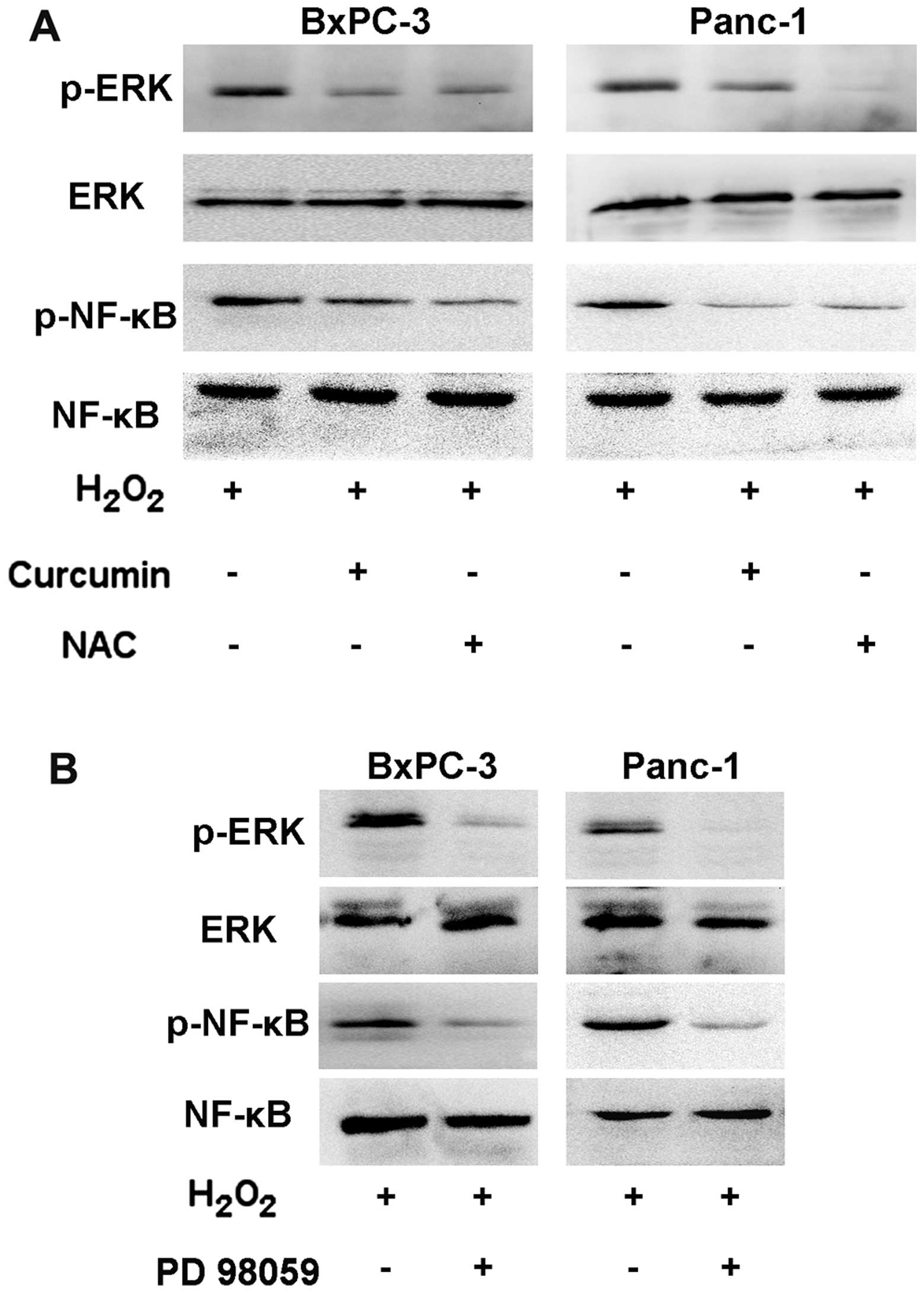Curcumin inhibits H2O2-induced invasion and migration of human pancreatic cancer via suppression of the ERK/NF-κB pathway
- Authors:
- Published online on: August 25, 2016 https://doi.org/10.3892/or.2016.5044
- Pages: 2245-2251
Abstract
Introduction
As the fourth leading cause of cancer death worldwide, pancreatic cancer is an aggressive malignant and lethal disease with a 5-year survival rate of less than 5% (1). Although the incidence of most other cancers have been declining, the rate of incidence for pancreatic cancer continues to increase by 1.5% per year (1). Surgery is the selected treatment option; however, it is only applicable to less than 20% of pancreatic cancer patients because of the late presentation and rapid progression of pancreatic tumors (2). Current treatments for inoperable patients are still limited to chemotherapy, radiation or both (3). Thus, more constructive and effective therapeutic strategies are urgently needed. In recent years, a variety of studies have shown that many natural agents are able to inhibit the progression of pancreatic cancer, but the underlying mechanisms of these agents are still not fully understood (4,5).
Curcumin (diferuloylmethane), a natural polyphenol present in turmeric, has many biological effects, including anti-infectious, anti-inflammatory, and antioxidant, as well as chemopreventive activities (6). More recently, curcumin has also been found to possess anticancer properties that affect a variety of biological pathways involved in tumorigenesis, cell cycle regulation, apoptosis, angiogenesis, immune activity regulation and metastasis (7). Extensive studies have verified that curcumin is involved in the regulation of multiple cellular signaling pathways, including the mitogen-activated protein kinase (MAPK), nuclear factor-κB (NF-κB), Akt, Wnt/β-catenin and other pathways (6).
Reactive oxygen species (ROS) generated by the mitochondrial respiratory chain are a number of chemically reactive molecules derived from oxygen, such as superoxide anion, hydrogen peroxide (H2O2) and others. Accumulating evidence indicates that the intracellular redox state plays an important role in cellular signaling transduction and regulates multiple events (8). On one hand, an excessive amount of ROS production can kill cancer cells, whereas sublethal concentrations of ROS can stimulate tumor progression by promoting cell proliferation, survival, invasion and metastasis (9). Additionally, our previous study showed that H2O2 (0–200 µM) could promote pancreatic cancer progression in a dose-dependent manner, while H2O2 was cytotoxic at concentrations above 200 µM (10). A recent study showed that curcumin possesses a protective effect against the epithelial-mesenchymal transition (EMT) process in the prostate tumor-stromal interaction, which is dependent on its ability to ameliorate cancer-associated fibroblast-induced ROS production through the MAOA/mTOR/HIF-1α signaling pathway (11).
The MAPK signaling pathways are important signaling cascades downstream of ROS that are involved in tumor progression (12). Members of the MAPK family include extracellular signal-regulated kinase (ERK), c-jun NH-2 terminal kinase (JNK) and p38 MAPK. Our previous study demonstrated that a moderate amount of H2O2 is able to promote pancreatic cancer invasion via the activation of the ERK and p38 MAPK signaling pathways (10). However, the ability of curcumin to inhibit the H2O2-induced progression of pancreatic cancer and the mechanisms related to this process have not been elucidated.
In the present study, we tested the hypothesis that curcumin is able to inhibit pancreatic cancer cell proliferation and suppress the H2O2-induced invasion and migration of pancreatic cancer cells. We also investigated the effect of curcumin on H2O2-induced activation of the ERK/NF-κB signaling pathway. The results from this study suggest that curcumin may be a novel therapy option for pancreatic cancer via the inhibition of the ERK/NF-κB signaling pathway.
Materials and methods
Cell culture and reagents
The human pancreatic cancer cell lines BxPC-3 and Panc-1 were obtained from the American Type Culture Collection (ATTC; Manassas, VA, USA). The cells were cultured in Dulbecco's modified Eagle's medium (DMEM) containing 10% dialyzed heat-inactivated fetal bovine serum (FBS), 100 U/ml penicillin, and 100 µg/ml streptomycin in a humidified atmosphere of 5% CO2 at 37°C. DMEM and FBS were purchased from Gibco (Grand Island, NY, USA). Curcumin, N-acetylcysteine (NAC) and MTT were purchased from Sigma-Aldrich (St. Louis, MO, USA). Millicell Transwells used in the invasion assays were obtained from Millipore Corp. (Billerica, MA, USA). Matrigel was purchased from BD Biosciences (Bedford, MA, USA). The primary antibodies against (MMP)-2 and MMP-9 were from Santa Cruz Biotechnology, Inc. (Santa Cruz, CA, USA). The anti-ERK, anti-phospho-ERK (Thr202/Tyr204), anti-NF-κB and anti-phospho-NF-κB (Ser468) antibodies were obtained from Cell Signaling Technology, Inc. (Beverly, MA, USA). The nitrocellulose membranes used were from Millipore Corp. The BCA assay kit and the chemiluminescence kit were bought from Pierce (Rockford, IL, USA). Other reagents were purchased from common commercial sources. All drug solutions were freshly prepared on the day of testing.
MTT assay
BxPC-3 and Panc-1 cells were seeded in 96-well plates at a density of 1×104 cells/well and incubated overnight in 10% FBS medium. The cells were then treated with curcumin (0, 5, 10, 20 and 40 µM). After incubation for 24, 48 and 72 h at 37°C, 15 µl of the MTT solution [5 mg/ml in phosphate-buffered saline (PBS)] was added to each well, and the cells were incubated for 4 h at 37°C. Then, 100 µl of DMSO were added to each well. The optical density (OD) value at 490 nm was determined using a spectrophotometer (Bio-Rad, Berkeley, CA, USA). The results are presented as the percentage relative to the control. The proliferation inhibition rate was calculated as (1 − ODsample/ODcontrol) × 100%.
Measurement of intracellular ROS
The level of intracellular ROS was measured using a ROS assay kit. In brief, the cells were incubated with 2,7-dichlorodihydrofluorecein diacetate (DCFDA) for 30 min and washed with PBS three times, and their fluorescence intensity was measured using a fluorometer (Becton-Dickinson, San Diego, CA, USA) with an excitation of 488 nm and an emission of 525 nm.
Wound healing assay
The migratory ability of the cells was detected by a wound healing assay. Pancreatic cancer cells were seeded in 24-well plates (1.0×105 cells/500 µl). After the cells grew to 90–100% confluency, a sterile pipette tip was used to produce a wound line between the cells. The cellular debris was removed by washing with PBS, and then, the cells were allowed to migrate for 24 h. Images were taken at 0 and 24 h post-wounding using a Nikon Diaphot TMD inverted microscope (magnification, ×10). The relative distance traveled by the leading edge from 0 to 24 h was assessed using the Photoshop software (n=5).
Transwell Matrigel invasion assay
The invasion of pancreatic cancer cells was tested using Transwell chambers. The 8.0-µm pore inserts were coated with 25 µl of Matrigel. The cell suspensions (5×104) were added to the upper chambers containing DMEM with 1% FBS. Simultaneously, 500 ml of DMEM containing 20% FBS was placed in the lower chambers. The cells were allowed to migrate for 48 h at 37°C. The non-invading cells were removed from the upper surface by a wet cotton swab. After rinsing with PBS, the filter was fixed and stained with crystal violet. The invasion ability was determined by counting the stained cells on the bottom surface. Three random fields were captured at ×20 magnification (n=3).
Real-time quantitative PCR (qT-PCR)
The total RNA was extracted from the pancreatic cancer cells using the Fastgen 200 RNA isolation system (Fastgen, Shanghai, China) according to the manufacturer's instructions. The total RNA was reverse-transcribed into cDNA using a PrimeScript RT reagent kit (Takara, Dalian, China). The primer sequences were as follows: MMP-2 forward, 5′-GAT GAT GCC TTT GCT CGT GC-3′ and reverse, 5′-CAA AGG GGT ATC CAT CGC CA-3′; MMP-9 forward, 5′-TGG TCC TGG TGC TCC TGG TG-3′ and reverse, 5′-GCT GCC TGT CGG TGAG ATT GG-3′; β-actin forward, 5′-GAC TTA GTT GCG TTA CAC CCT TTC T-3′ and reverse, 5′-GAA CGG TGA AGG TGA CAG CAG T-3′. The PCR reactions were subjected to a thermocycler program consisting of 30 sec at 95°C followed by 40 cycles of 95°C for 5 sec, 60°C for 30 sec and 72°C for 30 sec. For each qT-PCR data set, dissociation curve analysis was conducted. The relative gene expression was calculated using the 2−ΔΔCt method as previously reported (13).
Western blotting
The proteins in the samples were electrophoretically resolved on a denaturing SDS-polyacrylamide gel and electrotransferred onto nitrocellulose membranes. The membranes were initially blocked with 5% nonfat dry milk in Tris-buffered saline (TBS) for 2 h and then probed with each primary antibody. After co-incubation with the primary antibodies at 4°C overnight, the membranes were blotted with the secondary antibody for 2 h at 37°C. The results were visualized using an ECL western blotting substrate and photographed using GeneBox (Syngene, Frederick, MD, USA).
Statistical analysis
Statistical analysis was performed using SPSS software (version 17.0; SPSS Inc., Chicago, IL, USA). The data are presented as the means ± SEM of three replicate assays. Differences between the groups were assessed by an analysis of variance (ANOVA). Statistical significance was set at P<0.05. All experiments were repeated independently at least three times.
Results
Effect of curcumin on the proliferation of pancreatic cancer cells
In a previous study, curcumin (Fig. 1A) was shown to possess anti-proliferative activity against many tumor types (6). To investigate the cytotoxicity of curcumin on pancreatic cancer cells, BxPC-3 and Panc-1 cells were treated with curcumin at various concentrations (5, 10, 20 or 40 µM) for 24, 48 and 72 h. The results demonstrated that the proliferative abilities of both BxPC-3 and Panc-1 cells decreased in response to the treatment of curcumin in a time- and dose-dependent manner. Curcumin showed a 50% inhibitory concentration (IC50) of approximately 20 µM, and this concentration exhibited no cytotoxic effects in BxPC-3 or Panc-1 cells (Fig. 1B). Therefore, the treatment concentrations of 5, 10 and 20 µM of curcumin were used for the subsequent experiments.
Curcumin attenuates H2O2-induced oxidative stress in pancreatic cancer cells
Accumulating evidence indicates that ROS may play dual roles in cancer in a dose-dependent manner (9). Additionally, our previous study demonstrated that H2O2 could induce pancreatic cancer cell proliferation in a dose-dependent manner from 0 to 200 µM, while H2O2 was cytotoxic at concentrations above 200 µM (10). Therefore, 200 µM of H2O2 was used to treat the cells in the current experiments.
To explore the possible relationship between curcumin and oxidative stress, we first examined the effects of curcumin on H2O2-induced ROS production in BxPC-3 and Panc-1 cells using the cell-permeable and redox-sensitive compound DCFDA by flow cytometry. Our results showed that H2O2 significantly increased intracellular levels of ROS, while curcumin suppressed these effects in a dose-dependent manner. NAC, a scavenger of free radicals, also efficiently reduced the H2O2-induced ROS level in both BxPC-3 and Panc-1 cells (Fig. 2).
Curcumin inhibits the H2O2-induced invasion and migration of pancreatic cancer cells
A vital step of cancer metastasis is the invasion of cancer cells through the basement membrane. To examine the potential anti-invasive effects of curcumin, the invasion ability of BxPC-3 and Panc-1 cells treated with curcumin were analyzed. As shown in Fig. 3, H2O2 exposure significantly increased the invasive ability of pancreatic cancer cells, but the average cell number that invaded into the lower chamber decreased as the curcumin concentration increased from 5 to 20 µM. NAC also efficiently reduced the H2O2-induced invasive ability of the cancer cells.
The effect of curcumin on pancreatic cancer cell motility was determined using a wound healing assay. Our results showed that H2O2 exposure for 24 h caused a significant increase in the migration of both BxPC-3 and Panc-1 cells, whereas the cells treated with NAC and different concentrations (5, 10 and 20 µM) of curcumin showed dose-related delays in wound closure (Fig. 4). These findings indicate that curcumin may be an effective inhibitor of H2O2-induced migration and invasion of pancreatic cancer cells.
Curcumin downregulates the H2O2-induced expression of MMP-2 and MMP-9 in pancreatic cancer cells
Matrix metalloproteinases (MMPs) are zinc-dependent endopeptidases that degrade extracellular matrix components. Specifically, MMP-9 and MMP-2 are thought to facilitate cancer invasion and metastasis. As shown in Fig. 5, H2O2 exposure significantly increased the mRNA and protein expression levels of MMP-2 and MMP-9 in both BxPC-3 and Panc-1 cancer cells, while curcumin counterbalanced these effects of H2O2. The H2O2-induced expression of MMP-2 and MMP-9 could also be downregulated by NAC treatment.
Curcumin downregulates the activation of the ERK/NF-κB signaling pathway
The MAPK signaling pathways are important signaling cascades downstream of ROS that are involved in tumor migration and invasion (12). Our previous study showed that exposing BxPC-3 and Panc-1 cells to H2O2 for 15 min caused a significant increase in the phosphorylation level of ERK (10). In this study, we observed that the H2O2-induced level of p-ERK was inhibited after a 24-h treatment with curcumin or NAC without affecting its total expression. In addition, the H2O2-induced phosphorylation of NF-κB also strongly decreased with the addition of curcumin and NAC (Fig. 6A). Moreover, the ERK inhibitor PD 98059, could inhibit the expression of p-ERK and p-NF-κB, indicating that the NF-κB transcription factor is modulated by the ERK pathway (Fig. 6B). Taken together, our results demonstrate that curcumin inhibits H2O2-induced cancer progression via the suppression of the ERK/NF-κB signaling pathway in both BxPC-3 and Panc-1 cells.
Discussion
The potential antioxidant and anticancer effects of curcumin and its analogues have been extensively studied over the last three to four decades. Curcumin has been found to suppress the initiation, progression and metastasis of a variety of tumors (14,15). It has been reported that curcumin can inhibit pancreatic cancer cellular proliferation and upregulate the extrinsic apoptotic pathway through the activation of caspase-3, caspase-8, Bid, and Bax and the downregulation of NF-κB and Bcl-2 genes (16). Curcumin is also able to inhibit lipopolysaccharide-induced EMT through the downregulation of NF-κB-Snail signaling in breast cancer cells (17). Curcumin and its analogues (UBS109, EF31) have been found to inhibit multiple angiogenic pathways and suppress tumor angiogenesis (18). Toden et al (19) recently demonstrated that curcumin-mediated sensitization to 5-FU in colorectal cancer cells occurs through the suppression of EMT and the polycomb repressive complex, which are regulated by miRNAs. In addition, curcumin can also mediate several immune processes and help restore anticancer activities, such as the restoration of the CD4+/CD8+ T cell populations, the reduction of the Treg cell population and the suppression of T cell apoptosis (7,20.21). Our study demonstrated that curcumin could effectively inhibit the H2O2-induced invasive and migratory abilities of pancreatic cancer cells.
Accumulating evidence indicates that curcumin inhibits tumor progression via multiple cellular signaling pathways. Kim et al (22) showed that curcumin inhibits TPA-induced invasion by reducing MMP-9 activation, mainly through the PKCα, MAPK and NF-κB/AP-1 pathways, in human breast cancer cells. Curcumin can also reverse the transforming growth factor-β1 (TGF-β1)-induced EMT of pancreatic cancer cells by inhibiting the Hedgehog signaling pathway (23). Shakibaei et al (24) showed that combining curcumin with conventional chemotherapeutic agents, such as 5-FU, could provide more effective treatment against chemo-resistant colon cancer cells, which may be mediated by the NF-κB/PI-3K/Src pathways. In addition, Lu et al (25) showed that curcumin is able to suppress the proliferation and invasion of non-small cell lung cancer by modulating the MTA1-mediated Wnt/β-catenin pathway. Our present study proved that curcumin could inhibit H2O2-induced cancer invasion and migration via the suppression of the ERK/NF-κB signaling pathway.
ROS may play dual roles in cancer progression in a dose-dependent manner. On one hand, excess ROS production can cause oxidative damage to DNA and genomic instability and trigger cancer cell death; on the other hand, mild intracellular ROS can stimulate tumor progression by promoting cell proliferation, survival, invasion and metastasis (9). Our previous studies have demonstrated that both hyperglycemic conditions and superoxide dismutase (SOD)-induced mild ROS production were able to promote the invasive and migratory activity of pancreatic cancer (26,27). In the present study, our results showed that the effects of H2O2-induced intracellular ROS could be inhibited by curcumin or NAC to reduce cell invasion and migration, which also support this perspective. It has been reported that dietary supplementation of curcumin to male mice was able to increase the activities of glutathione peroxidase, glutathione reductase, glucose-6-phosphate dehydrogenase and catalase and induce glutathione S-transferase and quinine reductase, which can further neutralize ROS derived from chemical carcinogens (28). Curcumin can also induce heme oxygenase-1, an important ROS scavenging enzyme, via nuclear factor 2-related regulation (29). Recent studies have also shown that curcumin could abrogate ROS production via the MAOA/mTOR/HIF-1α signaling pathway (11). Our data showed that curcumin inhibits H2O2-induced cancer progression via the suppression of the ERK/NF-κB signaling pathway in pancreatic cancer cells.
The MAPK signaling pathways are important signaling cascades downstream of ROS that are involved in tumor migration and invasion (12). Lee et al (30) showed that hepatocyte growth factor regulates H2O2 production, which further activates the ERK pathway and regulates uPA production, eventually increasing the invasive potential of stomach cancer cells. Our recent study showed that SOD could promote the EMT of pancreatic cancer cells via the activation of the H2O2/ERK/NF-κB axis (26). We also demonstrated that H2O2 could promote the activation of p-ERK, p-p38, p-NF-κB and p-c-Jun, and in turn, promote pancreatic cancer cell invasion (10). The depletion of H2O2 by catalase inhibits the activation of the MAPK signaling pathways and tumor invasion (10). Several studies have demonstrated that the MAPK pathways, especially that of ERK, regulate MMP expression (31,32). Our previous study demonstrated that miR-106a can induce the over-expression of MMPs, which can further promote pancreatic cancer cell invasion (33). Additionally, the expression of MMPs is downregulated when the ROS/ERK pathway is blocked (34). The present study determined that the inhibition of the ROS/ERK pathway by curcumin could downregulate the expression of MMP-2 and MMP-9, which in turn attenuates cell invasion and migration.
In conclusion, the present study demonstrates that curcumin plays an important role in suppressing the proliferation, migration and invasion of pancreatic cancer cells via the ROS/ERK/NF-κB signaling pathway. These results suggest that curcumin may be a potential anticancer agent for the treatment of pancreatic cancer.
Acknowledgments
This study was supported by the National Natural Science Foundation of China (grant serial nos. 81502840 and 81301846).
References
|
Siegel RL, Miller KD and Jemal A: Cancer statistics, 2015. CA Cancer J Clin. 65:5–29. 2015. View Article : Google Scholar : PubMed/NCBI | |
|
Vincent A, Herman J, Schulick R, Hruban RH and Goggins M: Pancreatic cancer. Lancet. 378:607–620. 2011. View Article : Google Scholar : PubMed/NCBI | |
|
Gall TM, Tsakok M, Wasan H and Jiao LR: Pancreatic cancer: Current management and treatment strategies. Postgrad Med J. 91:601–607. 2015. View Article : Google Scholar : PubMed/NCBI | |
|
Díaz Osterman CJ, Gonda A, Stiff T, Sigaran U, Valenzuela MM, Ferguson Bennit HR, Moyron RB, Khan S and Wall NR: Curcumin induces pancreatic adenocarcinoma cell death via reduction of the inhibitors of apoptosis. Pancreas. 45:101–109. 2015. View Article : Google Scholar : PubMed/NCBI | |
|
Li W, Ma J, Ma Q, Li B, Han L, Liu J, Xu Q, Duan W, Yu S, Wang F, et al: Resveratrol inhibits the epithelial-mesenchymal transition of pancreatic cancer cells via suppression of the PI-3K/Akt/NF-κB pathway. Curr Med Chem. 20:4185–4194. 2013. View Article : Google Scholar | |
|
Shanmugam MK, Rane G, Kanchi MM, Arfuso F, Chinnathambi A, Zayed ME, Alharbi SA, Tan BK, Kumar AP and Sethi G: The multifaceted role of curcumin in cancer prevention and treatment. Molecules. 20:2728–2769. 2015. View Article : Google Scholar : PubMed/NCBI | |
|
Bose S, Panda AK, Mukherjee S and Sa G: Curcumin and tumor immune-editing: Resurrecting the immune system. Cell Div. 10:62015. View Article : Google Scholar : PubMed/NCBI | |
|
Lee DJ and Kang SW: Reactive oxygen species and tumor metastasis. Mol Cells. 35:93–98. 2013. View Article : Google Scholar : PubMed/NCBI | |
|
Nishikawa M, Hashida M and Takakura Y: Catalase delivery for inhibiting ROS-mediated tissue injury and tumor metastasis. Adv Drug Deliv Rev. 61:319–326. 2009. View Article : Google Scholar : PubMed/NCBI | |
|
Li W, Ma Z, Ma J, Li X, Xu Q, Duan W, Chen X, Lv Y, Zhou S, Wu E, et al: Hydrogen peroxide mediates hyperglycemia-induced invasive activity via ERK and p38 MAPK in human pancreatic cancer. Oncotarget. 6:31119–31133. 2015.PubMed/NCBI | |
|
Du Y, Long Q, Zhang L, Shi Y, Liu X, Li X, Guan B, Tian Y, Wang X, Li L, et al: Curcumin inhibits cancer-associated fibroblast-driven prostate cancer invasion through MAOA/mTOR/HIF-1α signaling. Int J Oncol. 47:2064–2072. 2015.PubMed/NCBI | |
|
Wu WS, Wu JR and Hu CT: Signal cross talks for sustained MAPK activation and cell migration: The potential role of reactive oxygen species. Cancer Metastasis Rev. 27:303–314. 2008. View Article : Google Scholar : PubMed/NCBI | |
|
Livak KJ and Schmittgen TD: Analysis of relative gene expression data using real-time quantitative PCR and the 2(−Delta Delta C(T)) Method. Methods. 25:402–408. 2001. View Article : Google Scholar | |
|
Duan W, Chang Y, Li R, Xu Q, Lei J, Yin C, Li T, Wu Y, Ma Q and Li X: Curcumin inhibits hypoxia inducible factor-1α-induced epithelial-mesenchymal transition in HepG2 hepatocellular carcinoma cells. Mol Med Rep. 10:2505–2510. 2014.PubMed/NCBI | |
|
Lei J, Huo X, Duan W, Xu Q, Li R, Ma J, Li X, Han L, Li W, Sun H, et al: α-Mangostin inhibits hypoxia-driven ROS-induced PSC activation and pancreatic cancer cell invasion. Cancer Lett. 347:129–138. 2014. View Article : Google Scholar : PubMed/NCBI | |
|
Youns M and Fathy GM: Upregulation of extrinsic apoptotic pathway in curcumin-mediated antiproliferative effect on human pancreatic carcinogenesis. J Cell Biochem. 114:2654–2665. 2013. View Article : Google Scholar : PubMed/NCBI | |
|
Huang T, Chen Z and Fang L: Curcumin inhibits LPS-induced EMT through downregulation of NF-κB-Snail signaling in breast cancer cells. Oncol Rep. 29:117–124. 2013. | |
|
Nagaraju GP, Zhu S, Ko JE, Ashritha N, Kandimalla R, Snyder JP, Shoji M and El-Rayes BF: Antiangiogenic effects of a novel synthetic curcumin analogue in pancreatic cancer. Cancer Lett. 357:557–565. 2015. View Article : Google Scholar | |
|
Toden S, Okugawa Y, Jascur T, Wodarz D, Komarova NL, Buhrmann C, Shakibaei M, Boland CR and Goel A: Curcumin mediates chemosensitization to 5-fluorouracil through miRNA-induced suppression of epithelial-to-mesenchymal transition in chemoresistant colorectal cancer. Carcinogenesis. 36:355–367. 2015. View Article : Google Scholar : PubMed/NCBI | |
|
Dhillon N, Aggarwal BB, Newman RA, Wolff RA, Kunnumakkara AB, Abbruzzese JL, Ng CS, Badmaev V and Kurzrock R: Phase II trial of curcumin in patients with advanced pancreatic cancer. Clin Cancer Res. 14:4491–4499. 2008. View Article : Google Scholar : PubMed/NCBI | |
|
Kanai M, Yoshimura K, Asada M, Imaizumi A, Suzuki C, Matsumoto S, Nishimura T, Mori Y, Masui T, Kawaguchi Y, et al: A phase I/II study of gemcitabine-based chemotherapy plus curcumin for patients with gemcitabine-resistant pancreatic cancer. Cancer Chemother Pharmacol. 68:157–164. 2011. View Article : Google Scholar | |
|
Kim JM, Noh EM, Kwon KB, Kim JS, You YO, Hwang JK, Hwang BM, Kim BS, Lee SH, Lee SJ, et al: Curcumin suppresses the TPA-induced invasion through inhibition of PKCα-dependent MMP-expression in MCF-7 human breast cancer cells. Phytomedicine. 19:1085–1092. 2012. View Article : Google Scholar : PubMed/NCBI | |
|
Sun XD, Liu XE and Huang DS: Curcumin reverses the epithelial-mesenchymal transition of pancreatic cancer cells by inhibiting the Hedgehog signaling pathway. Oncol Rep. 29:2401–2407. 2013.PubMed/NCBI | |
|
Shakibaei M, Mobasheri A, Lueders C, Busch F, Shayan P and Goel A: Curcumin enhances the effect of chemotherapy against colorectal cancer cells by inhibition of NF-κB and Src protein kinase signaling pathways. PLoS One. 8:e572182013. View Article : Google Scholar | |
|
Lu Y, Wei C and Xi Z: Curcumin suppresses proliferation and invasion in non-small cell lung cancer by modulation of MTA1-mediated Wnt/β-catenin pathway. In Vitro Cell Dev Biol Anim. 50:840–850. 2014. View Article : Google Scholar : PubMed/NCBI | |
|
Li W, Cao L, Han L, Xu Q and Ma Q: Superoxide dismutase promotes the epithelial-mesenchymal transition of pancreatic cancer cells via activation of the H2O2/ERK/NF-κB axis. Int J Oncol. 46:2613–2620. 2015. | |
|
Li W, Ma Q, Li J, Guo K, Liu H, Han L and Ma G: Hyperglycemia enhances the invasive and migratory activity of pancreatic cancer cells via hydrogen peroxide. Oncol Rep. 25:1279–1287. 2011.PubMed/NCBI | |
|
Iqbal M, Sharma SD, Okazaki Y, Fujisawa M and Okada S: Dietary supplementation of curcumin enhances antioxidant and phase II metabolizing enzymes in ddY male mice: Possible role in protection against chemical carcinogenesis and toxicity. Pharmacol Toxicol. 92:33–38. 2003. View Article : Google Scholar : PubMed/NCBI | |
|
Balogun E, Hoque M, Gong P, Killeen E, Green CJ, Foresti R, Alam J and Motterlini R: Curcumin activates the haem oxygenase-1 gene via regulation of Nrf2 and the antioxidant-responsive element. Biochem J. 371:887–895. 2003. View Article : Google Scholar : PubMed/NCBI | |
|
Lee KH, Kim SW and Kim JR: Reactive oxygen species regulate urokinase plasminogen activator expression and cell invasion via mitogen-activated protein kinase pathways after treatment with hepatocyte growth factor in stomach cancer cells. J Exp Clin Cancer Res. 28:732009. View Article : Google Scholar : PubMed/NCBI | |
|
Gallelli L, Falcone D, Scaramuzzino M, Pelaia G, D'Agostino B, Mesuraca M, Terracciano R, Spaziano G, Maselli R, Navarra M, et al: Effects of simvastatin on cell viability and proinflammatory pathways in lung adenocarcinoma cells exposed to hydrogen peroxide. BMC Pharmacol Toxicol. 15:672014. View Article : Google Scholar : PubMed/NCBI | |
|
Poudel B, Lee YM and Kim DK: DDR2 inhibition reduces migration and invasion of murine metastatic melanoma cells by suppressing MMP2/9 expression through ERK/NF-κB pathway. Acta Biochim Biophys Sin (Shanghai). 47:292–298. 2015. View Article : Google Scholar | |
|
Li P, Xu Q, Zhang D, Li X, Han L, Lei J, Duan W, Ma Q, Wu Z and Wang Z: Upregulated miR-106a plays an oncogenic role in pancreatic cancer. FEBS Lett. 588:705–712. 2014. View Article : Google Scholar : PubMed/NCBI | |
|
Chen Y, Zheng L, Liu J, Zhou Z, Cao X, Lv X and Chen F: Shikonin inhibits prostate cancer cells metastasis by reducing matrix metalloproteinase-2/-9 expression via AKT/mTOR and ROS/ERK1/2 pathways. Int Immunopharmacol. 21:447–455. 2014. View Article : Google Scholar : PubMed/NCBI |



